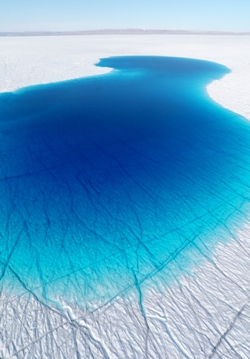
In this article, we redress the balance, and in so doing demonstrate the basis of our concern for current and future ice-mass recession and its contribution to sea-level rise. Our response is structured around five general themes that are misrepresented by Ollier in his argument that ice sheets are not responding to recent climate warming. These are
- that ice motion is predominantly achieved through ‘creep’,
- that iceberg calving and calving-related processes do not influence the motion of the interior ice sheet,
- that current rates of ice-mass flow and iceberg release are not controlled by recent, but by ancient, changes in climate,
- that ice sheets have been stable for long periods of time and are therefore insensitive to changes in climate, and
- that contemporary advance of certain valley glaciers indicates that there is no evidence of climate warming.
Misconception 1: theories based on ice sliding on a lubricated base have very limited application because ice motion is predominantly achieved through ‘creep’
Ollier states that “theories based on ice sliding on a lubricated base have very limited application” and that ice-sheet flow is achieved almost entirely through ice deformation or creep. This statement is erroneous, and ignores the fact that the majority of the Earth’s ice masses move through a combination of ice deformation and basal motion, composed of basal sliding and the deformation of subglacial sediments. Indeed, where direct measurements have been made of the relative contributions of the different motion components, basal motion often accounts for as much as 80% of the total ice velocity. This has been observed at small temperate mountain glaciers as well as at 50km-wide ice streams in Antarctica. Indeed, it has been estimated that c.90% of the annual ice loss from Antarctica, and c.50% of that from Greenland
2,3, occurs through the discharge of ice streams and outlet glaciers, the rapid motion of which is facilitated by the presence of basal meltwater. Numerous studies correspondingly reveal that fast ice motion, and rapid changes in motion, are overwhelmingly controlled by variations in basal motion and not creep – which is rate-limited and relatively steady, and insensitive to changing external forcing factors. It is only variations in basal motion, therefore, that are capable of explaining the dramatic changes in the rates at which ice streams move that have been recorded in the past decade or so.
Satellite images clearly show that surface meltwater forms lakes and supraglacial rivers on the Greenland Ice Sheet, even well up into the firn zone, and much of this water seasonally drains to the bed. The seasonal speed up of the western margin of the Greenland Ice Sheet has been observed from satellites
4 and from ground-based GPS measurements
5. In some cases the ice surface has speeded up by up to a factor of four. Continuous centimetre-accurate geodetic-GPS measurements made across and up to 100 km from the margin of the Greenland ice sheet further indicate a strong daily cycle of horizontal and vertical displacement, both synchronous with, and proportional to, the timing and magnitude of diurnal surface melt-water production
6,7.
That this observed daily velocity cycle is also accompanied by extensive vertical uplift of the ice surface, both of which are in phase with peak melt-water production, provides a direct link between surface melt and subglacial ice dynamics, and specifically with hydraulic-pressurisation (inducing uplift) at the ice-bed interface.
Ollier disregards a large body of observational evidence by claiming that meltwater does not form on ice caps. He also disregards observational evidence when he claims that water can only penetrate through the ice if crevasses reach the bed. Every part of these statements is inaccurate. For example, the process of hydro-fracturing provides a mechanism for extending surface crevasses to depth, while water-melted sink holes, or ‘moulins’ very effectively transfer water from the surface of ice masses to their bed – even through ice thicknesses of up to one kilometre
8. Although the impact of this process is still unclear, the evidence for drainage of water through thick polar ice, from the surface of the ice sheet to the bed, is incontrovertible.
Even in areas where there is little or no surface melting, as is the case for most of Antarctica, the beds of ice streams are generally lubricated as a result of basal melting. Basal melting occurs under thick ice where the combination of overburden pressure and the geothermal heat-flux result in ice at the bed being at the pressure-melting point, even though mean annual surface temperatures are c.20
oC or even colder. Once fast flow has been initiated, strain-heating and bed friction also contribute to basal melting.